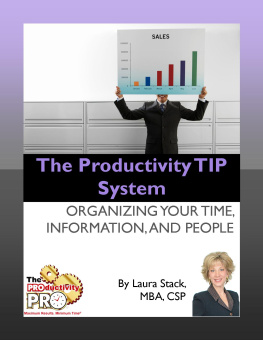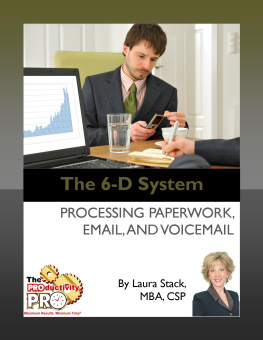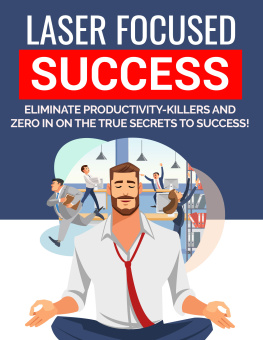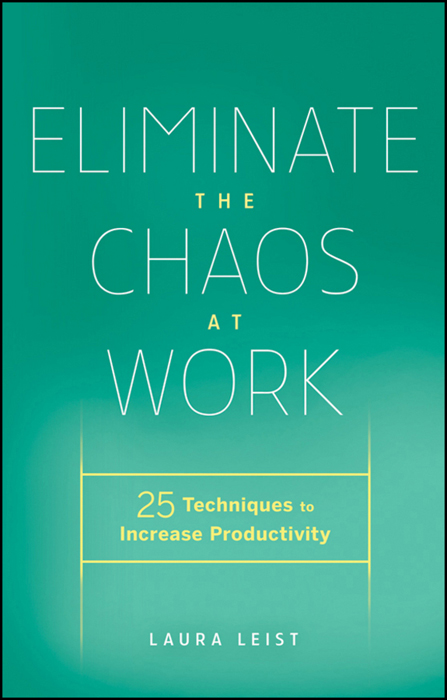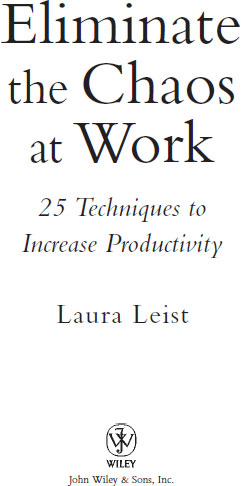Copyright 2011 Laura Leist. All rights reserved.
Published by John Wiley & Sons, Inc., Hoboken, New Jersey.
Published simultaneously in Canada.
No part of this publication may be reproduced, stored in a retrieval system, or transmitted in any form or by any means, electronic, mechanical, photocopying, recording, scanning, or otherwise, except as permitted under Section 107 or 108 of the 1976 United States Copyright Act, without either the prior written permission of the Publisher, or authorization through payment of the appropriate per-copy fee to the Copyright Clearance Center, Inc., 222 Rosewood Drive, Danvers, MA 01923, (978) 750-8400, fax (978) 646-8600, or on the web at www.copyright.com . Requests to the Publisher for permission should be addressed to the Permissions Department, John Wiley & Sons, Inc., 111 River Street, Hoboken, NJ 07030, (201) 748-6011, fax (201) 748-6008, or online at http://www.wiley.com/go/permissions .
Limit of Liability/Disclaimer of Warranty: While the publisher and author have used their best efforts in preparing this book, they make no representations or warranties with respect to the accuracy or completeness of the contents of this book and specifically disclaim any implied warranties of merchantability or fitness for a particular purpose. No warranty may be created or extended by sales representatives or written sales materials. The advice and strategies contained herein may not be suitable for your situation. You should consult with a professional where appropriate. Neither the publisher nor author shall be liable for any loss of profit or any other commercial damages, including but not limited to special, incidental, consequential, or other damages.
Designations used by companies to distinguish their products are often claimed as trademarks. In all instances where John Wiley & Sons, Inc. is aware of a claim, the product names appear in initial capital or all capital letters. Readers, however, should contact the appropriate companies for more complete information regarding trademarks and registrations.
For general information on our other products and services or for technical support, please contact our Customer Care Department within the United States at (800) 762-2974, outside the United States at (317) 572-3993 or fax (317) 572-4002.
Wiley also publishes its books in a variety of electronic formats. Some content that appears in print may not be available in electronic books. For more information about Wiley products, visit our web site at www.wiley.com .
ISBN 978-0-470-87899-6 (cloth); ISBN 978-1-118-03042-4 (ebk);
ISBN 978-1-118-03043-1 (ebk); ISBN 978-1-118-03044-8 (ebk)
To my fianc, Robert Strasser,
who joined me on this journey
and provided his technology expertise to this book.
I love you!
Acknowledgments
I am grateful to so many individuals who helped make this book possible. Our clients and seminar participants provide many opportunities for me and our company Specialists to solve their office productivity and organization challenges. Each client brings a unique situation and encourages us to continually devise custom solutions to eliminate their chaos at work.
I thank my editor at John Wiley & Sons who reached out to me to inquire if I would be interested in writing a book on office organization and productivity. Thank you, Matt Holt, publisher, for the opportunity to collaborate with Wiley on this project.
Early in my career, I learned that I cant do it all and that I must delegate and trust the amazing employees Ive hired for their expertise. I am grateful for each of you for your amazing gifts and skill sets you offer to our clients. Thank you to each of you for believing in me and being part of our team.
As much as I wanted to write a book on productivity in the workplace and office organization, I did not want to add one more thing to my plate in 2010 when this manuscript was written. I had to consider that during this time I was still co-managing our practice, working with clients, speaking around the country, planning a wedding, and serving as the president of the National Association of Professional Organizers (NAPO). At the urging of Robert Strasser, my fianc and our Business Systems Consultant, we figured out a way to make it all possibleagreeing that we would postpone our wedding until 2011. I tried to convince Robert to co-author the book with me, but he wasnt interested, instead choosing to play a more behind-the-scenes role in the process and take on many more responsibilities at home so I could focus my time on writing. Thank you, Rob, for sharing your expertise and insights and for your love and supportI know this book would not have been possible during this time if it wasnt for you. Now, lets go plan our wedding!
Introduction
By picking up this book, you have made the decision to either be more productive at work or work in a more organized environment. Now the question remains: Where do I start? Its a question you need to answer as you begin this process. Your definition of working productively or being organized may be entirely different than the next individualsand thats okay.
It doesnt matter what industry you work in, or what your job title is; all offices can be broken down into four areas that usually require streamlined systems and processes to be created and maintained. While not every office will require work in all four areas, you need to identify at the onset which ones need improvement, so that youre clear about the goals you want to accomplish. Making statements like I need to get organized or I really wish I knew how to be more productive will get you nowhere if you do not understand exactly what is standing in your way or which areas need the most help.
These four areas are as follows:
Paper: This may include paper management systems, paper flow, and filing and retrieval systems.
Electronic Information: Any information stored electronically, such as documents, customer information, photos, and graphics.
Stuff: Anything that must live in the office that is not paper.
Time Management: The desire and ability to manage your time and prioritize tasks to ensure that you meet deadlines and achieve goals.
Now that you are aware of these areas, you should be easily able to identify which ones need the most help. Most individuals with whom I consult have identified more than one area; however, few people need to transform them all.
The beauty of this book is that you dont need to read it from cover to cover in order to make progress and see results in your office. You can simply turn to one of the four sections and use the information as your guide as you begin to create and implement your new systems. Once youve completed an area, you can move on to another section.
Whether you are an employee, business owner, CEO, or someplace in between, you can execute the information, concepts, processes, and the 25 techniques Ive introduced in these pages to fit your needs on a daily basis. You might also figure out somewhere along the way that your coworkers or employees could benefit from this information and these efforts as well. I encourage you to be a catalyst for change in these areas; the more productive your coworkers or employees are, the more positive will be the impact on the bottom line.
25 Techniques to Increase Productivity
Identify problem areas up front and set yourself up for success. (Chapter 2)
Learn how to manage your actions and choose to spend your time. (Chapter 3)




